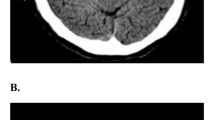Abstract
Purpose:
In the anterior circulation, the hyperdense middle cerebral artery sign (HMCAS) is a well established marker for early ischemia. Similarly, the hyperdense basilar artery sign may be a diagnostic clue for basilar artery thrombosis. Other hyperdense artery signs have not yet been described. The purpose of this study was to define the hyperdense posterior cerebral artery sign (HPCAS) and determine its incidence, diagnostic value, and reliability as a marker for ischemia in the territory of the posterior cerebral artery (PCA).
Methods:
CCTs of 69 patients with proven acute ischemia in the PCA territory were compared by three independent and blinded readers to the CCTs of 86 age-matched patients without PCA infarction. Using follow-up imaging, the correlation of the HPCAS with infarct size, thalamic infarction and bleeding were investigated.
Results:
A HPCAS was found in 37.7% of all patients with PCA-infarction, typically within the ambient cistern with a specificity of 95.4%. The thalamus was affected significantly more often (p = 0.03), and the size of the infarct was significantly more often large than medium or small (p = 0.02) when a HPCAS was present. Hemorrhagic transformation tended to occur more often when the HPCAS was present.
Conclusion:
HPCAS was detected in more than one third of all patients with PCA ischemia, suiting the incidence of the HMCA. Based on our results, this sign may not only be helpful in the early diagnosis of PCA infarction but might also act as a prognostic marker in acute PCA territory ischemic stroke.
Zusammenfassung
Ziel:
Bei der bildgebenden Diagnostik zerebraler Ischämien kommt den so genannten Infarktfrühzeichen im CCT eine entscheidende Bedeutung zu. In der vorderen Zirkulation ist die hyperdense Media (HM) ein etabliertes Frühzeichen für eine Ischämie im Mediaterritorium. Das Ziel dieser retrospektiven Studie war es, die Wahrscheinlichkeit und die Spezifität der hyperdensen A. cerebri posterior (HP) als Frühzeichen für eine Ischämie im Posteriorterritorium zu bestimmen.
Methodik:
Die CCTs von 69 Patienten mit im Verlauf bewiesener frischer Ischämie im Posteriorterritorium sowie die CCTs von 86 Patienten ohne Ischämie wurden von drei unabhängigen und geblindeten Neuroradiologen bezüglich HP und anderer Infarktfrühzeichen beurteilt. Bei der Verumgruppe lag ein Kontroll-CCT vor, das nach Abschluss der Studie im Konsensus nach Infarktgröße, thalamischer Beteiligung und hämorrhagischer Transformation beurteilt wurde.
Ergebnisse:
Eine HP wurde bei 37,7% aller Patienten der Verumgruppe mit einer Spezifität von 95,4% gefunden. Bei 6% der Patienten der Verumgruppe war die HP das einzige Ischämiefrühzeichen. Die Größe des Infarktes (p = 0,02) und die thalamische Beteiligung (p = 0,03) korrelierten positiv mit der HP. Eine Hämorrhagie trat bei sieben Patienten auf, fünf von ihnen hatten eine HP (marginale Signifikanz).
Schlussfolgerung:
Die Auftretenswahrscheinlichkeit der HP ist ähnlich der der HM (37% vs. etwa 40%). Als einziges Zeichen einer Ischämie ist die HP jedoch nur bei unter 10% aller Patienten vorhanden. Es fand sich eine hohe Korrelation mit der Größe des Infarktes, der thalamischen Beteiligung und eine Tendenz zu einer vermehrten hämorrhagischen Transformation. Wir schließen daraus, dass eine HP sowohl als Frühzeichen als auch als prognostischer Faktor bei der Ischämie im Posteriorterritorium bedeutsam sein kann.
Similar content being viewed by others
Author information
Authors and Affiliations
Corresponding author
Rights and permissions
About this article
Cite this article
Krings, ., Nölchen, D., Willmes, K. et al. The Hyperdense Posterior Cerebral Artery. Clin Neuroradiol 16, 33–40 (2006). https://doi.org/10.1007/s00062-006-6003-3
Received:
Accepted:
Issue Date:
DOI: https://doi.org/10.1007/s00062-006-6003-3




